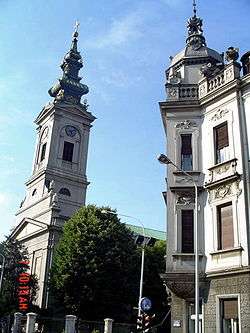Religious architecture in Belgrade
Belgrade, Serbia has an abundance of religious architecture. The city has numerous Serbian Orthodox churches and temples and it is also the seat of the Patriarch of the Serbian Orthodox Church. Its two most prominent Orthodox Christian places of worship are the Saborna Crkva (the Cathedral Church) and the Temple of St. Sava, the largest Eastern Orthodox church in the world.

Other notable Belgrade churches include St. Mark's Church, in which rests the body of the first Serbian Emperor, Stefan Dušan. The architecture of this church was greatly inspired by the Gračanica monastery in the province of Kosovo. The church of Sveta Ružica in the Kalemegdan Fortress is one of the holiest places in Belgrade for Serbian Orthodox Christians since this was the site where the body of St. Paraskeva was preserved for several years after the Ottoman conquest, before being taken to Romania where it still rests today. St. Paraskeva (Sv. Petka) is one of the most important saints to the Eastern Orthodox Christians.
Belgrade is the seat of a Catholic archdiocese, with a small Catholic community and several Catholic churches. One of these, St Anthony's, was designed by the noted Slovenian architect Jože Plečnik.
There is also a Muslim community in Belgrade and only one mosque, the Bajrakli Mosque built in 1526 by the Ottoman Sultan, Suleiman the Magnificent. It is one of the oldest surviving structures in contemporary Belgrade.
The Jewish community is served by the Belgrade Synagogue, which is the only currently active Jewish place of worship in the entire country, although not the only such structure within the city limits.
Belgrade also had an active Buddhist temple in the first half of the 20th century. It was built by East Russian expatriates fleeing the outcome of the Bolshevik Revolution of 1917.
Orthodox
- Church of St. Alexander Nevsky, Dorćol
- Church of St. Basil of Ostrog, Bežanija
- Church of St. Nicholas, Zvezdara
- Church of St. George, Banovo Brdo
- Church of St. George, Oplenac
- Church of St. Jovan Vladimir, Voždovac
- Church of St. Tryphon, Čukarica
- Church of Saint Sava, Vračar
- Church of the Convocation of Serbian Saints, Palilula
- Church of the Holy Apostles Peter and Paul, Topčider
- Church of the Holy Father Nikolaj, Zemun, built in 1725–1731
- Church of the Holy Trinity, Voždovac
- Church of the Holy Trinity, Vračar
- Church of the Holy Trinity, Zemun
- Russian Church of the Holy Trinity
- Church of the Holy Emperor Lazar
- Church of the Nativity of the Most Holy Mother of God, Zemun, built in 1780
- Church of the Nativity of the Most Holy Mother of God, Zvezdara
- Church of the Nativity of St. John the Baptist, Voždovac
- Ružica Church, Kalemegdan
- St. Michael's Cathedral
- St. Mark's Church
- Monastery of St. Archangel Gabriel, Zemun, its church was built in 1786, on a site of older church
- Crkva Svetog Dimitrija (Zemun)
- Crkva Svetog djakona Avakuma i igumana Pajsija (Zemun)
- Rajinovac monastery
- New Cemetery Church
Roman Catholic
- Co-cathedral of Christ the King in Belgrade, built in 1927
- Church of St. Anthony of Padua, Belgrade
- Crkva uznesenja blažene djevice Marije (Zemun), built in 1795, Roman Catholic, built on a site of previous mosque
- Crkva svetog Roka (Zemun), built in 1836, Roman Catholic
- Samostan Svetog Ivana Krstitelja i Antuna (Zemun), built in 1750-1752, Franciscan/Roman Catholic
Islamic
Protestant
- Evangelical Church, Zemun, built in 1920s, Evangelical
Synagogues
- The Sukkat Shalom Belgrade Synagogue
- Zemun Synagogue, built in early 20th century, sold to a restaurant owner during Slobodan Milošević's rule, but the Jewish Municipality of Zemun is trying to recuperate the building.